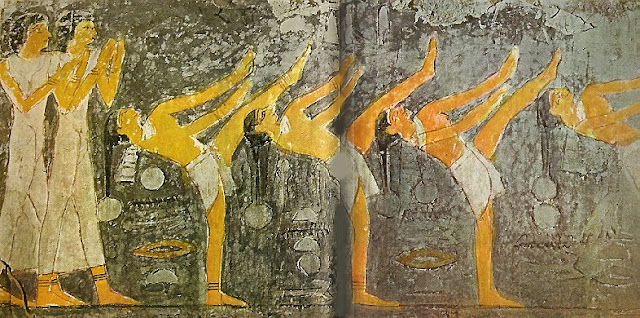Tomb of Mehu
Tomb of Mehu
Mehu was ‘Chief Justice and Vizier’ during the early part of Dynasty VI, probably during the reigns of Teti and Pepy I, and was married to three wives. One of his wives, Iku, is named as ‘King’s daughter of His Body’ and the others were Nebt and Nefertkawes. Mehu’s tomb is among those to the north of the Unas causeway, east of the mastaba of Princess Idut and although it is not at present open to visitors it has some of the most colourful and exquisite reliefs of the whole necropolis.The mastaba of Mehu, which was discovered by Zaki Saad and excavated by Salam Hussein in 1940, has four decorated chambers with a large courtyard. The axis of the tomb is east to west, with its entrance at the eastern end depicting Mehu on either side of the doorway. The left-hand wall of the first chamber is decorated with scenes of trapping birds with nets, mending the nets and preparing food for the birds. Other reliefs in this room show the deceased in hunting and fishing scenes and on the eastern wall there are birds in their nests.
A long corridor runs westwards and in its entrance there are four registers of baking, brewing and preparing birds for a meal (on the left) and a man carrying a calf (on the right). Scenes illustrating daily life continue down the length of the passage – the harvest, fishing with nets, freight ships and sailing boats, and metalworkers beating, smelting and weighing their materials are just some of the beautifully coloured pictures here. In the right-hand wall there is a doorway to a large courtyard which has two square pillars at the western end depicting the deceased on each face. Behind these is the false door of Mehu’s son Kahotep and other walls are painted with scenes of offerings and gardening.
At the far end of the corridor there are fruit-pickers above a doorway and at either side men bring offerings to the tomb-owner. The reliefs here are beautifully preserved and show some unusual colours. Offerings include a bull, oryx and gazelles as well as baskets of fruit. Many more offerings are depicted around the walls of the following small chamber, together with scenes of musicians, including four harpists, dancers and clappers.
A doorway to the right (north) leads into a long chapel where offerings would be placed before Mehu’s false door stela at the western end, to sustain him in the afterlife. The well-preserved false door has an unusual style of decoration in which the limestone of the stela shows through dark red paint (which was used to simulate granite) highlighting the hieroglyphic text in yellow and resulting in a superbly detailed piece of craftsmanship. The blue-grey colour of the walls in Mehu’s chapel forms an unusual background for the colourful reliefs which depict many more offerings (especially birds) with priests and offering-lists. The deceased is shown seated before a table to receive them.
A smaller chamber to the south of Mehu’s offering chapel belonged to another individual called Meryre-ankh, ‘Inspector of Priests of the Pyramid of Pepy I’. It would appear that Mehu usurped this tomb from its original owner, leaving the offering chapel of Meryre-ankh intact, complete with the scenes of offerings, offering-bringers and his false-door stela.
Entrance
The mastaba of Mehu is not at present open to visitors. However, the tomb has recently been restored by the Egyptian Antiquities Organisation, and hopefully will be open sometime in the future.

ليست هناك تعليقات:
إرسال تعليق